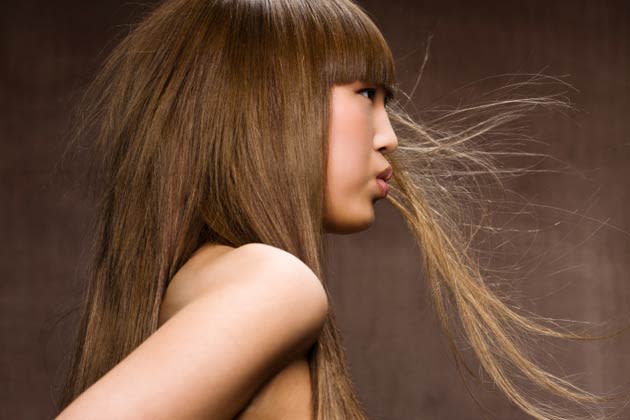Five Ways You’re Damaging Your Hair

By Maui V. Reyes for Yahoo! Southeast Asia
Having a tough time getting shiny, healthy looking hair? If you find yourself lusting after luscious locks, there's a big change you've got damaged hair. And you're in good company.
A study commissioned by global beauty brand Dove found that 80% of women suffer from damaged hair, but only 20% realize that the symptoms they're experiencing are a result of said damage. And while damaged hair may not be the end of the world, it's not a problem that some can just shrug off: the same study found that around 40% of the women respondents said that a bad hair day stopped them from doing things they needed to do (such as errands, meeting up with friends, etc).
If you're wondering how your hair even got into this mess, chances are, you have your everyday hair-related routine to blame. Surprisingly, simple things such as hair-brushing and towel-drying habits could cause your locks to be rough, brittle, and prone to split ends. (Think you don't have damaged hair? Try this test: curl a single strand of hair around your finger and drop it into a glass of water. If it takes long for the strand of hair to spring back to its original form, then you've got unhealthy hair.)
Read on to find out what else you could be doing that's keeping you from having a shiny, healthy mane and how you can still have fun with your hair while minimizing the damage.
1. Regularly expose your hair to chemicals. Hair is fiber, it's bundled in the middle, enclosed by a protective cuticle which is always the first to get damaged. Certain chemicals, when applied to the hair, can damage the cuticle, making the inner fibers more vulnerable.
Bleaching, usually done to "lighten" or "change" hair color, strips the melanin in your hair—which means changing its normal structure. Perms, on the other hand, break the inner bonds of hair, only to re-form them together, building a new structure (which explains how a perm can either straighten or make your hair curly). Both treatments change the hair's basic structure, which in turn removes the protein bonds that keep our hair strong and lustrous.
Can't keep from sitting in the salon chair? Make sure you don't skip on the daily conditioner and weekly treatment hair mask. You can also try "hair-healthy" salon alternatives, such as organic dyes or even henna. These, however, do not give you the same results as chemical treatments.
2. Use heat to style. Exposing your hair to excess heat cracks the cuticles and removes its moisture—leaving it dry and brittle. If you reach for any heat-styling tools (flat irons, curling irons, hot rollers, and your hair dryer) on a daily basis, always make sure you protect your hair.
Heat protectant products like serums protect the hair from the damaging effects of blow drying or using flat irons. You can also apply leave-on conditioners to give your hair a protective barrier from the heat. That way, the heat will be frying the product, not your hair. When blow drying hair, keep the nozzle a good six inches away from your tresses.
3. Brush with the wrong comb. Combs come in different shapes and sizes for a reason: to be used on certain hair types, at different times of the day. The idea is finer bristles should be paired with fine hair. For example, fine to medium-haired gals should use natural boar-bristle brushes, while thick haired/curly girls should stick to brushes with individually-spaced bristles with coated tips, since uncoated tips might break hair.
As a general rule, you shouldn't brush wet hair: they tend to be more fragile, so using a fine-toothed brush to fight tangles will only damage your locks. Instead, use a wide-toothed comb. And don't think that brushing your hair a hundred times a day will leave you with shiny, healthy hair. Your hair may look shiny, but that's just because your constant brushing helped distribute the oils from your scalp to your tresses…but in the process, you've also exposed your hair to too much friction. The result? Split ends and more breakage.
4. Wash too often. You need to shampoo your hair to cleanse your scalp and remove oil build-up. But shampoo too much, too often, and you'll be doing more harm than good. Washing your hair too much can strip your hair of moisture, making your hair dull and dry.
Try to not be too vigorous with your tresses when you hit the shower, since too much friction makes it prone to breakage, as well. Try to find a "hair washing frequency" that works for you, as well: if you have oily hair, you might want to wash your hair every day. If your hair is on the dry side, shampooing every other day should do the trick. Using a shampoo with hair repair properties can also help.
5. Sport "tight" hairstyles. We're a big fan of the ponytail, especially since it's so versatile (it keeps our hair off our face at the gym, and transforms us into sleek vixens at night). But be wary of pulling your hair back too tight.
Too-tight hair styles can cause hair to break, and damage can be permanent if you do it too often. So try to keep your ponytails and braids loose as much as you can. If you really have to constantly style your hair in tight buns or ponytails (say, if your job entails you to keep that updo all day), don't forget to let your hair down—literally. Give your hair a break from all that tugging and pulling, and your hair will thank you in the form of less hair fall and breakage.

